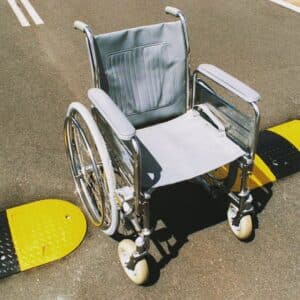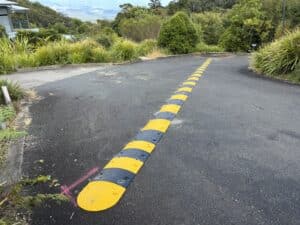

In Australian retirement communities, ensuring a safe and accessible environment is crucial. Managing vehicle speeds is a key part of protecting pedestrians, many of whom have mobility issues. Speed humps are a common solution to slow down traffic and enhance safety. However, their installation needs to be carefully balanced to maintain accessibility, especially for residents using wheelchairs. Let’s explore the benefits and challenges of Speed humps in Australian retirement communities and discuss the best practices for implementing them.

Retirement communities are designed to be safe and comfortable for older adults. Many residents have reduced mobility, making them more vulnerable to vehicle accidents. That’s why it’s so important to have traffic calming measures like speed humps. They ensure cars drive at safer speeds, reducing the risk of accidents.
Speed humps are great at slowing down traffic. Studies show they can cut vehicle speeds by up to 25%, which significantly reduces the chance of pedestrian accidents. In retirement communities, where many people walk or use mobility aids, keeping vehicle speeds down is crucial for everyone’s safety.
While speed humps are great for slowing down traffic, they can be tricky for accessibility. For residents in wheelchairs or those using walkers, going over speed humps can be tough and uncomfortable. So, it’s important to design and install speed humps in a way that balances traffic calming with accessibility.
Gradual Slopes: Speed humps should have gentle slopes to ensure that vehicles, including those driven by residents and service providers, can pass over them smoothly. This design reduces the jolt experienced by passengers, including those in wheelchairs.
Width and Height: The width and height of speed humps should be carefully considered. Wider and lower humps are generally more wheelchair-friendly. They still effectively reduce vehicle speeds but are easier for wheelchairs to navigate.
Materials and Surface: The materials used for speed humps should provide a non-slip surface to prevent wheelchairs from sliding. Additionally, the surface should be smooth to ensure a comfortable ride for wheelchair users.
Placement: The placement of speed humps should be strategic. They should be installed in areas where traffic calming is most needed, such as near pedestrian crossings, entrances, and exits. However, they should not be placed in locations where they would create obstacles for residents with mobility issues.
Engaging with residents is key when putting in speed humps in retirement communities. Listening to their concerns and preferences helps in designing solutions that work for everyone. Regular surveys and community meetings can provide valuable feedback on how well the speed humps are working and what improvements might be needed.
Community Meetings: Regular meetings to discuss traffic calming measures and gather feedback ensure residents feel involved in the decision-making process. This leads to greater acceptance and cooperation.
Surveys: Distributing surveys to gather residents’ opinions on current traffic measures and any issues they face provides valuable data. This feedback can guide adjustments to existing measures or the implementation of new solutions.
Informational Sessions: Conducting informational sessions about the benefits of speed humps and how they improve safety helps residents understand the importance of these measures. These sessions can also address any concerns residents may have.
While speed humps are effective, they’re not the only option. Sometimes alternative solutions are more suitable, especially if speed humps pose significant accessibility challenges.
Speed Cushions: Similar to speed humps, speed cushions have gaps to allow wheelchairs and emergency vehicles to pass through easily. They provide the same traffic-calming benefits but are more accessible.
Raised Crosswalks: Raised crosswalks slow down traffic and provide a safe crossing point for pedestrians. They’re particularly useful in areas with high pedestrian traffic.
Chicanes and Bends: Creating chicanes or bends in the road naturally slows down traffic. This can be combined with other traffic calming solutions to enhance safety.
Signage and Enforcement: Increasing signage to remind drivers of speed limits and the presence of vulnerable pedestrians is effective. Enforcing speed limits through regular patrols or speed cameras helps maintain safe driving behaviours.
Visual and Auditory Cues: Using visual and auditory cues, such as rumble strips or painted road markings, can alert drivers to slow down. These measures can complement speed humps and provide additional safety benefits.
A comprehensive traffic calming strategy in retirement communities should incorporate a combination of measures tailored to the specific needs of the community. This approach ensures both safety and accessibility are effectively addressed.
Assessment and Planning: Conducting a thorough assessment of the community’s traffic patterns, pedestrian areas, and potential hazards is the first step. This should involve input from residents, traffic engineers, and community managers.
Selection of Measures: Based on the assessment, selecting a combination of traffic calming measures that address the community’s specific needs is crucial. This selection should prioritize both safety and accessibility.
Pilot Testing: Implementing pilot tests of the selected measures can help identify any issues and gather feedback from residents. Adjustments can be made based on this feedback before full-scale implementation.
Implementation and Monitoring: Rolling out the traffic calming measures across the community and continuously monitoring their effectiveness is important. Regular reviews and adjustments ensure the measures remain effective and address any emerging issues.
Community Engagement: Keeping residents informed and involved throughout the process fosters a sense of ownership and cooperation. Regular updates and feedback sessions help maintain a positive relationship between residents and community managers.
Balancing safety and accessibility in retirement communities is a complex but essential task. Speed humps are a valuable tool for reducing vehicle speeds and enhancing pedestrian safety. However, their design and implementation must consider the needs of all residents, particularly those with mobility issues. By focusing on gradual slopes, appropriate width and height, suitable materials, and strategic placement, communities can effectively use speed humps without compromising accessibility.
Engaging with residents and considering alternative traffic calming measures can further enhance the safety and accessibility of retirement communities. With thoughtful planning and ongoing feedback, it is possible to create a safe and inclusive environment for all residents. Implementing a comprehensive traffic calming strategy that includes a combination of measures tailored to the community’s specific needs ensures that both safety and accessibility are prioritised. Through continuous engagement and monitoring, retirement communities can achieve a harmonious balance between vehicle speed control and the mobility requirements of their residents.
At Speed Humps Australia, we’ve spent more than 15 years focusing on one thing: to provide one style of product and to do it exceptionally well. We have worked tirelessly to develop specifications that do not fade or deteriorate, are easy to install, and are made from high-quality, recycled rubber for minimal environmental impact.
With just a handful of our clients around the nation including KFC, McDonalds, Taco Bell, Westfield, Shell and numerous Local Governments, our rumble bars, speed humps and wheel stops have been purposefully designed and truly go the distance.
As our design and production are all handled in-house and supplied Australia-wide, get in touch with us today to request a quote or discuss how we can help with providing a tailored solution to your unique project requirements.



For 10 years, our focus has been on one thing: to provide one style of product and to do it well.
Our wheel stops, speed humps and rumble bars meet Australian Standards, don’t fade, and we’ve never needed to replace one.

For 10 years, our focus has been on one thing: to provide one style of product and to do it well.
Our wheel stops, speed humps and rumble bars meet Australian Standards, don’t fade, and we’ve never needed to replace one.